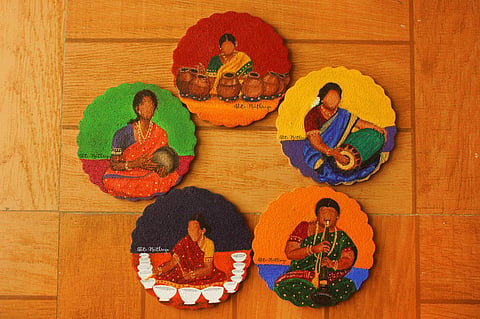

It was after watching a video of a woman playing the jaltarang to the tune of Shankar Mahadevan’s Breathless that Aditi Maithreya first learned about female instrumental artists. She was just fascinated by someone playing that tune on the jaltarang. Such was her interest that she then went on to research some more about these women and found out that there were quite a few who excelled in their respective art, not only in the domestic arena but also on the international stage. “But I hadn’t come across any woman percussion instrumentalists playing a nadaswaram at a wedding or a mridangam at a concert,” she says, adding, “This is what made me research whether there were more such women playing instruments that I didn’t know about.” And that is what prompted her to capture these women through her art on cork coasters as part of her lockdown series on Instagram, Off Beat but In Tune.
Speaking about her decision to use cork coasters for her art, Aditi laughingly says, “I love to hoard art supplies and had purchased these five cork coasters before the lockdown to paint on. But I hadn’t used them and was waiting for the right opportunity. This series was a great excuse to use them creatively. They have now become more like art pieces and are not being used as ordinary coasters.” Aditi painted some the coasters with acrylic colours and the results were resplendent.
One of the most striking things to note about the female instrumentalists depicted on the coasters is that they don’t have any facial features. Aditi explains, “I wanted to depict a woman playing these instruments. Each photo caption contains the name of two to three women who have played or are still playing the instrument depicted. So it doesn’t refer to anyone in particular.” Aditi has, however, referred to photos of the women she mentions in the captions as inspiration to capture them in her artworks. “I needed a reference without which it would have been very difficult to draw it accurately,” she recalls.
And it is indeed the captions that draw our attention. Meticulously researched, Aditi has three posts dedicated to each instrument. While one features a woman playing the instrument, the other two gives information about the instrument itself - why is it known thus, where it is played and so on - and also about the instrument makers. “I have not spoken to any of the artists I have mentioned nor to any of the other instrument makers. All my research is from secondary sources, which have been cited appropriately in each and every post,” says Aditi. So you’ll learn how the ghatam is an idiophone - which vibrates as whole to produce the sound - or that the mridangam’s body is made from the wood of a jackfruit tree.
Aditi also talks about where the instruments are made. For example, she discusses how the best ghatams are made in Manamadurai, where people from various place travel to get ghatams with a metallic tonal quality. In her post, Aditi says, “The late Meenakshi Kesavan and her family have a long-standing legacy of creating the Manamadurai variety [of Ghatam] and could probably be the only family to still do it. She is also possibly the first instrument maker to receive the Sangeet Natak Akademi Award in 2014.” Such interesting trivia awaits you on Instagram on the 26-year-old's Instagram page @aditimaithreya.
